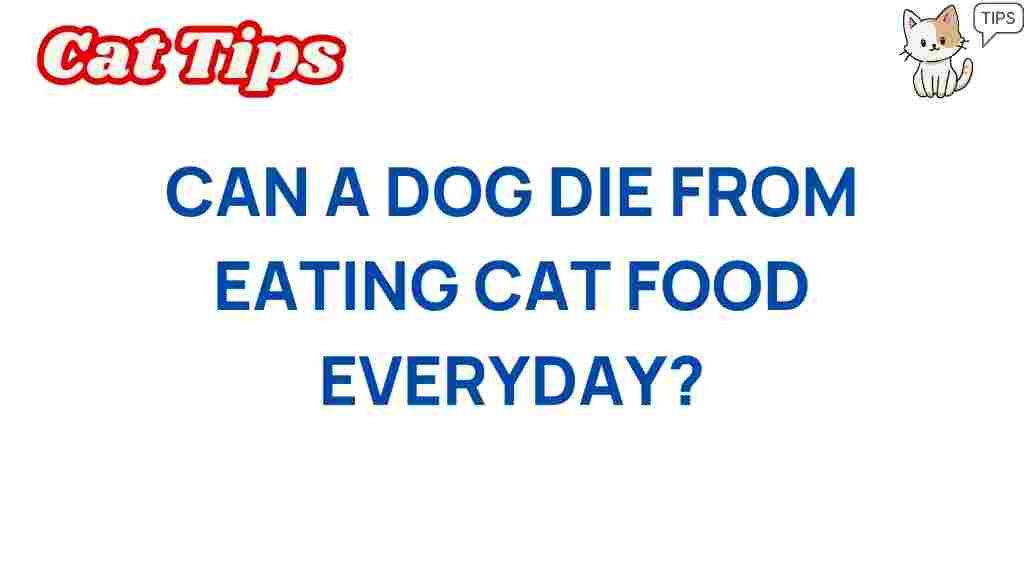The Surprising Risks: Can a Dog Die from Eating Cat Food Daily? – Understanding Dog Health
As a pet owner, you may have noticed your dog eyeing your cat’s food bowl with a mix of curiosity and desperation. It’s not uncommon for dogs to sneak a bite of cat food; however, many wonder if this behavior poses any serious risks to their dog’s health. While the occasional nibble may not cause immediate harm, feeding cat food to dogs on a daily basis can lead to serious health issues. In this article, we will explore the risks associated with dogs eating cat food regularly, why this happens, and how to prevent it.
Why Do Dogs Eat Cat Food?
Understanding the reasons behind this behavior can help you manage your pets more effectively. Here are some common reasons dogs might be drawn to cat food:
- Smell and Taste: Cat food is often richer and has a stronger aroma than dog food, making it more appealing to dogs.
- Curiosity: Dogs are naturally curious creatures. If they see their feline friends enjoying something, they may want to try it too.
- Hunger: Sometimes, dogs may turn to cat food if they are hungry or if their own food is not satisfying enough.
Potential Health Risks of Dogs Eating Cat Food
While dogs may find cat food delicious, regular consumption can have adverse effects on their health. Understanding these risks is crucial for any responsible pet owner. Here are some key health concerns:
1. Nutritional Imbalance
Dog and cat foods are formulated differently to meet the specific dietary needs of each species. Cat food is generally higher in protein and fat, which can lead to:
- Obesity: Dogs consuming high-fat cat food may gain weight rapidly, leading to obesity.
- Pancreatitis: A sudden intake of high-fat foods can inflame the pancreas, causing painful and potentially life-threatening conditions.
2. Toxic Ingredients
Some cat foods may contain ingredients that are harmful to dogs. Ingredients like onions, garlic, and certain preservatives can be toxic to dogs, causing:
- Gastrointestinal Distress: Vomiting, diarrhea, or lethargy may occur.
- Long-term Health Issues: Continuous exposure to harmful substances can lead to serious health problems over time.
3. Increased Thirst and Urination
Due to their higher protein content, cat food may cause dogs to drink more water and urinate more frequently. This can lead to:
- Dehydration: If a dog doesn’t have constant access to clean water, dehydration can become a serious problem.
- Kidney Issues: Increased workload on the kidneys can lead to long-term damage.
4. Allergies and Skin Issues
Dogs can also develop allergies to ingredients commonly found in cat food. Signs of an allergic reaction may include:
- Itchy Skin: Excessive scratching or biting at the skin.
- Ear Infections: Frequent ear infections can be a sign of allergies.
Signs Your Dog Is Having Issues from Eating Cat Food
If your dog has been eating cat food, it’s essential to monitor them for signs of distress. Look for these symptoms:
- Vomiting
- Diarrhea
- Excessive thirst or urination
- Weight gain or loss
- Skin irritations or infections
What to Do If Your Dog Eats Cat Food
If you’ve caught your dog munching on cat food, don’t panic. Here’s a step-by-step guide on what to do:
1. Monitor Your Dog
Keep a close eye on your dog for any changes in behavior or signs of distress. If they show symptoms mentioned earlier, consult a veterinarian.
2. Remove Access to Cat Food
The best prevention is to limit your dog’s access to cat food. Here are a few strategies:
- Separate Feeding Areas: Feed your pets in different rooms.
- Elevate Cat Food: Place cat food on a higher surface that your dog cannot reach.
- Train Your Dog: Use commands to discourage your dog from approaching the cat’s food.
3. Consult Your Veterinarian
If your dog has been consuming cat food regularly, it’s wise to schedule a check-up with your veterinarian. They can evaluate your dog’s health and suggest dietary adjustments.
Troubleshooting Tips for Managing Multiple Pets
Managing both cats and dogs can be challenging, especially when it comes to feeding. Here are some troubleshooting tips:
1. Choose the Right Food
Consider using high-quality pet food that meets the nutritional needs of both cats and dogs. Some brands offer formulas that are safe for both species.
2. Create a Feeding Schedule
Establish a feeding routine that allows you to supervise both pets during their meals to prevent sneaking. For example:
- Feed the dog and cat at the same time but in separate areas.
- Use timers to keep feeding sessions short.
3. Provide Engaging Activities
Keep your dog occupied with toys, exercise, and training to reduce their desire to raid the cat’s food bowl. A tired dog is less likely to seek out cat food!
Conclusion: Prioritizing Dog Health
While the occasional nibble of cat food is unlikely to cause immediate harm, consistent consumption can lead to significant health risks. As a responsible pet owner, it’s essential to understand the nutritional differences between dog and cat food and take steps to prevent your dog from eating cat food daily. By monitoring your dog’s health, creating separate feeding areas, and consulting with your veterinarian, you can ensure that your furry friend remains healthy and happy.
For more information on maintaining your pet’s health, check out this comprehensive guide on pet nutrition. And remember, prioritizing dog health is not just about what they eat, but how you manage their environment and lifestyle!
By staying informed and vigilant, you can provide the best care for your dog and avoid the surprising risks that come with feeding them cat food.
This article is in the category Nutrition and created by CatTips Team
